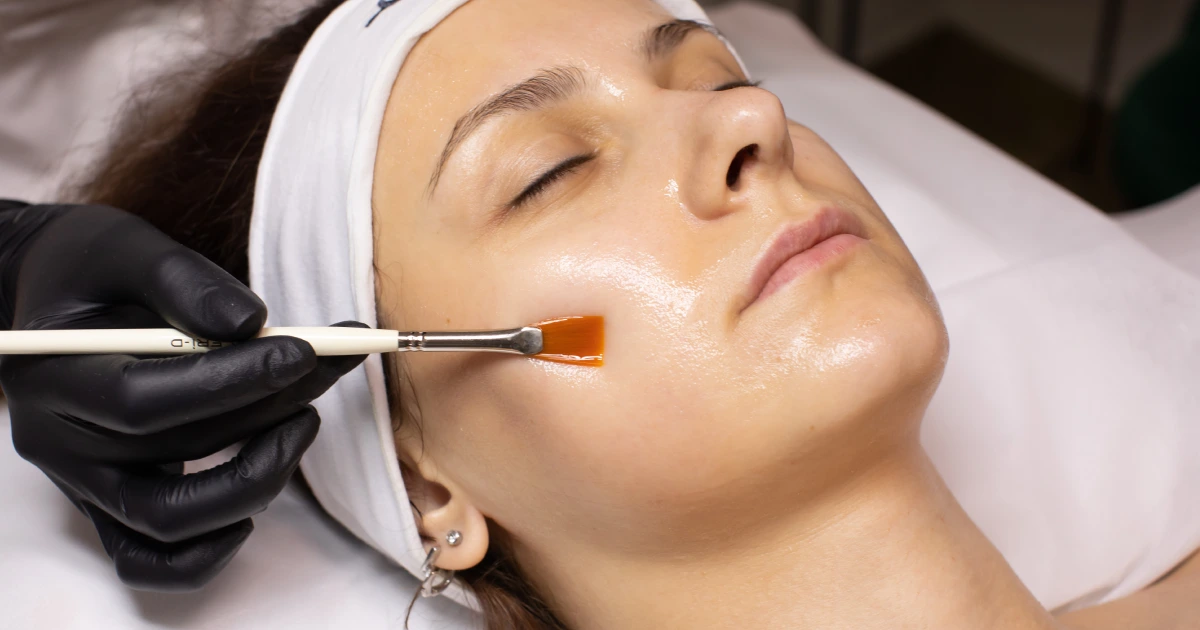Table of Contents

Introduction
Are you curious about chemical peels and their effects on your skin? You may have heard the term but need clarification on how they work or what conditions they can address. This comprehensive guide will demystify chemical peels, explaining how they work and the various skin concerns they can help address. Whether you want to rejuvenate your skin or tackle specific issues, discover the wonders of chemical peels.
Understanding Chemical Peels
What Are Chemical Peels?
Your skin’s appearance and texture can be improved with chemical peels. Exfoliating involves applying a chemical solution to remove dead skin cells. It results in a smoother and more youthful complexion by encouraging the growth of new, healthier skin cells.
How Do Chemical Peels Work?
Chemical peels work by using specially formulated solutions that contain various acids. These acids help remove the outermost layer of your skin, known as the epidermis. The depth of the peel and the type of acid used depends on your specific skin concerns and the desired outcome.
Types of Chemical Peels
- Superficial (Light) Peels: Superficial peels use mild acids like alpha hydroxy acids (AHAs) or beta hydroxy acids (BHAs). They target the outermost layer of skin and are typically used to address minor imperfections such as uneven skin tone, fine lines, and mild sun damage.
- Medium Peels: A medium peel penetrates deeper into the skin and often uses trichloroacetic acid (TCA). They can effectively treat more noticeable signs of aging, including wrinkles, age spots, and moderate sun damage.
- Deep Peels: Deep peels, typically employing phenol or high concentrations of TCA, penetrate even further into the skin. They are used for severe skin issues like deep wrinkles, scars, and significant sun damage. These peels require more downtime and may not be suitable for all skin types.
What Can Chemical Peels Treat?
1. Acne and Acne Scarring: Chemical peels can help reduce acne and minimize the appearance of acne scars. They work by unclogging pores, reducing inflammation, and promoting skin healing.
2. Fine Lines and Wrinkles: Superficial and medium peels can smooth out fine lines and wrinkles on your skin. They stimulate collagen production, plumping the skin and reducing signs of aging.
3. Sun Damage and Hyperpigmentation: Chemical peels effectively fade sunspots, age spots, and uneven pigmentation caused by sun exposure. They encourage shedding damaged skin cells, revealing a more even complexion.
4. Uneven Skin Tone and Texture: Chemical peels are helpful if your skin is rough or uneven. Your skin will be smoother and more radiant after they remove dead skin cells and stimulate cell turnover.
5. Melasma: Melasma is characterized by brownish-black facial patches, often caused by hormonal changes. Chemical peels can lighten these patches and improve overall skin tone.
6. Scars: It is possible to minimize the appearance of scars, including acne and surgical scars, with chemical peels. By encouraging new skin cell growth, they help fade scar tissue.
The Chemical Peel Procedure
- Consultation: Before getting a chemical peel, it’s essential to consult with a licensed dermatologist or skin care professional. They will assess your skin type, concerns, and medical history to determine the best peel for you.
- Preparation: Depending on the type of peel, your skin may need to be prepared in advance. This may involve using specific skincare products, avoiding sun exposure, or discontinuing certain medications.
- The Peel Application: A thorough skin cleansing will occur during the procedure. The chemical solution is applied to your face, neck, or other treated areas. An unpleasant sensation may occur, such as tingling or burning, which typically subsides quickly.
- Downtime and Aftercare: The recovery period will vary depending on how deep the peel is. Superficial peels may have minimal downtime, while deeper peels require several weeks of healing. Regardless of the peel type, it’s crucial to follow post-treatment instructions provided by your skincare professional, which often include applying sunscreen and moisturizing.
Chemical Peels Before and After
Before a Chemical Peel:
- Consult a skincare professional to determine the appropriate peel for your skin concerns.
- Discuss any allergies, sensitivities, or medical conditions that might affect the treatment.
- Follow pre-peel instructions, which may include discontinuing certain skincare products and medications.
- Arrive at the appointment with clean, makeup-free skin.
After a Chemical Peel:
- Follow post-peel care instructions diligently, including avoiding sun exposure and wearing sunscreen daily.
- Expect some redness, peeling, or flaking as your skin heals; this is normal.
- Be patient, as it may take several weeks to see the full results of your peel.
- Maintain a skincare routine tailored to your specific needs to prolong the benefits of the peel.
Conclusion
In summary, chemical peels are versatile skincare treatments that can address many skin concerns, from acne to sun damage and signs of aging. By exfoliating the skin’s outer layer and stimulating cell turnover, chemical peels promote a smoother, more radiant complexion.
Before getting a chemical peel, consult a qualified skincare professional to determine the most suitable type and depth of peel for your skin. Following proper pre-peel and post-peel care instructions will maximize results and minimize complications.
So, if you want to rejuvenate your skin and regain your youthful glow, consider scheduling a consultation with Via Fuse to explore the benefits of chemical peels. Say goodbye to skin imperfections and hello to a more vibrant you!
Remember, results may vary depending on your skin type and the specific concerns you wish to address. Consultation with a professional is always the first step towards achieving your skincare goals.


